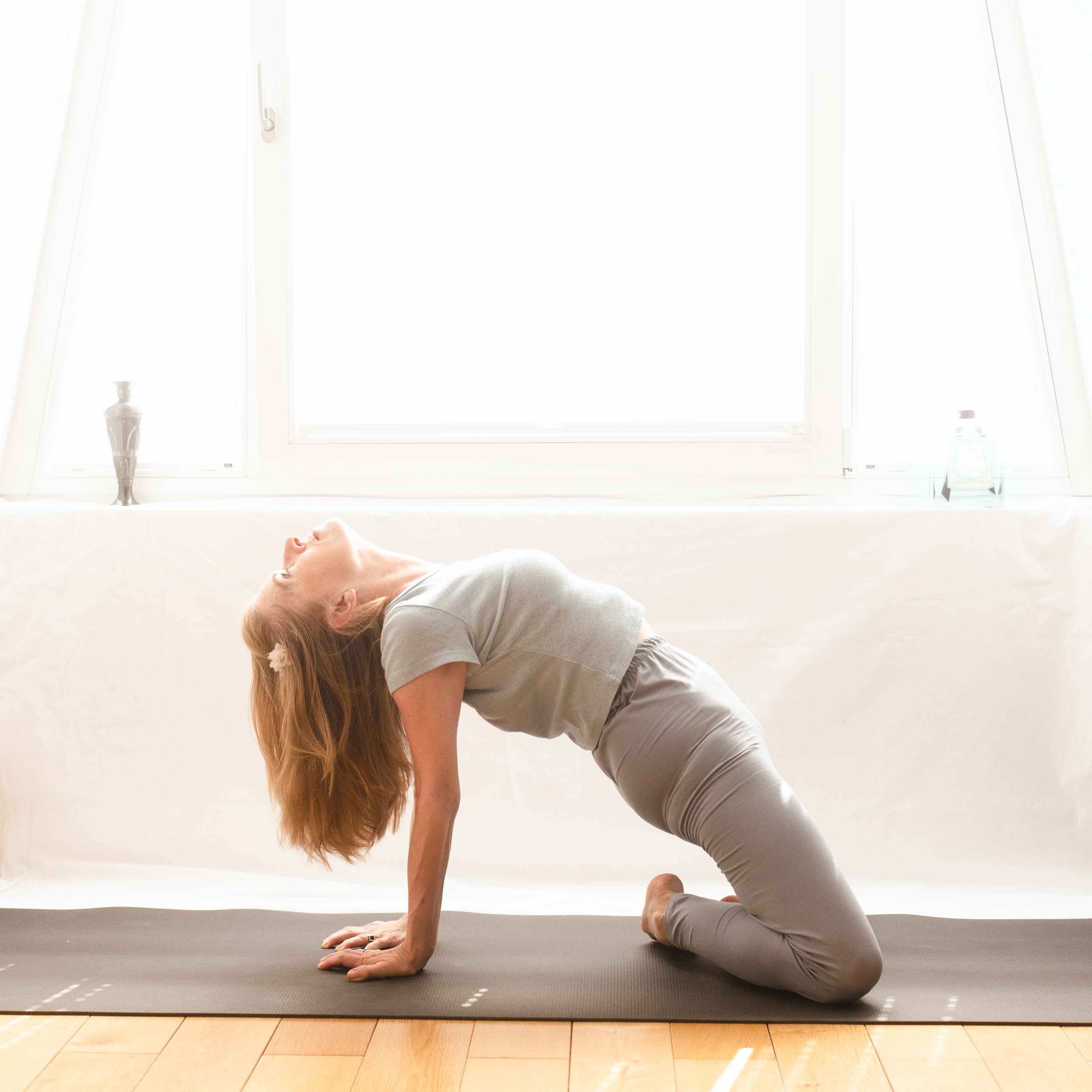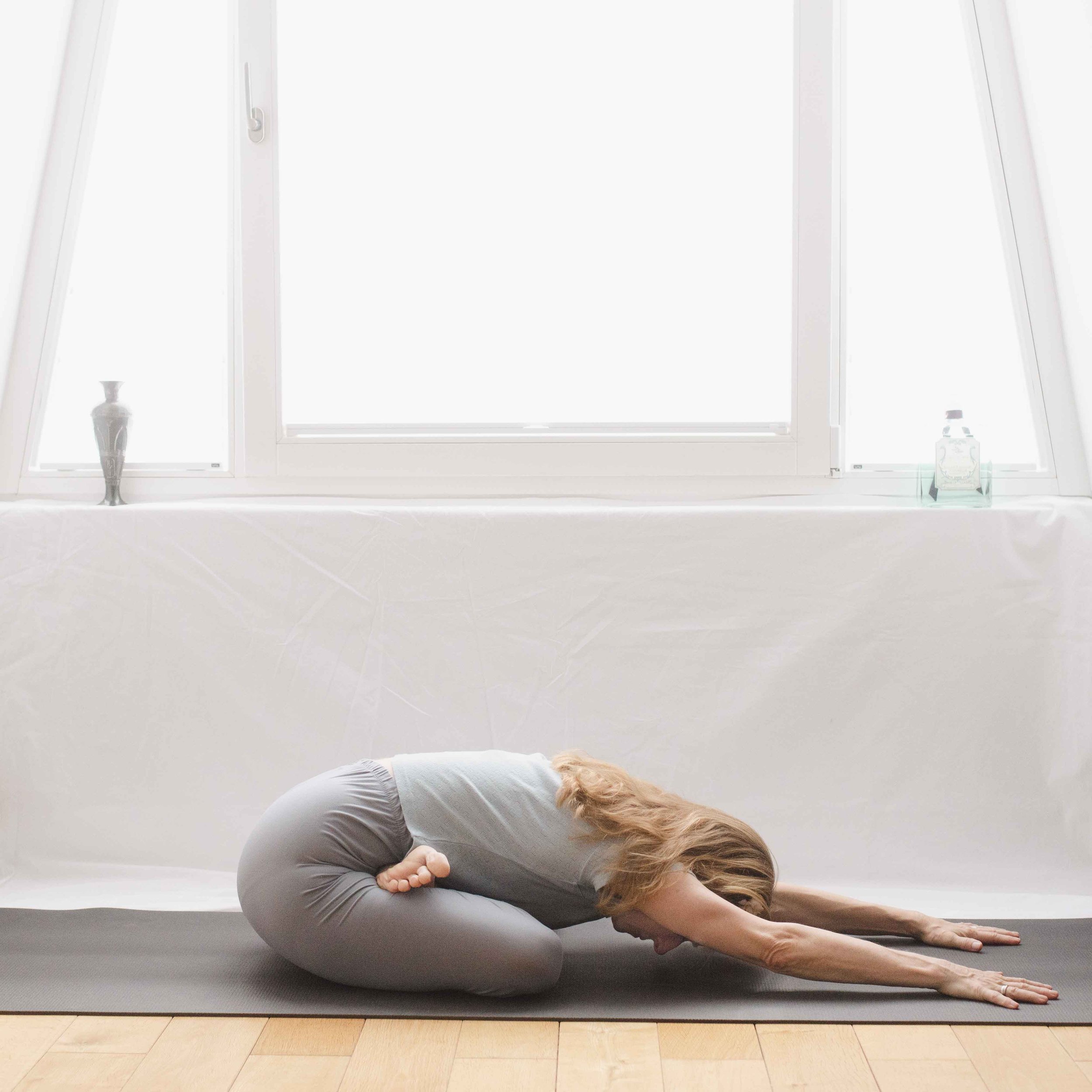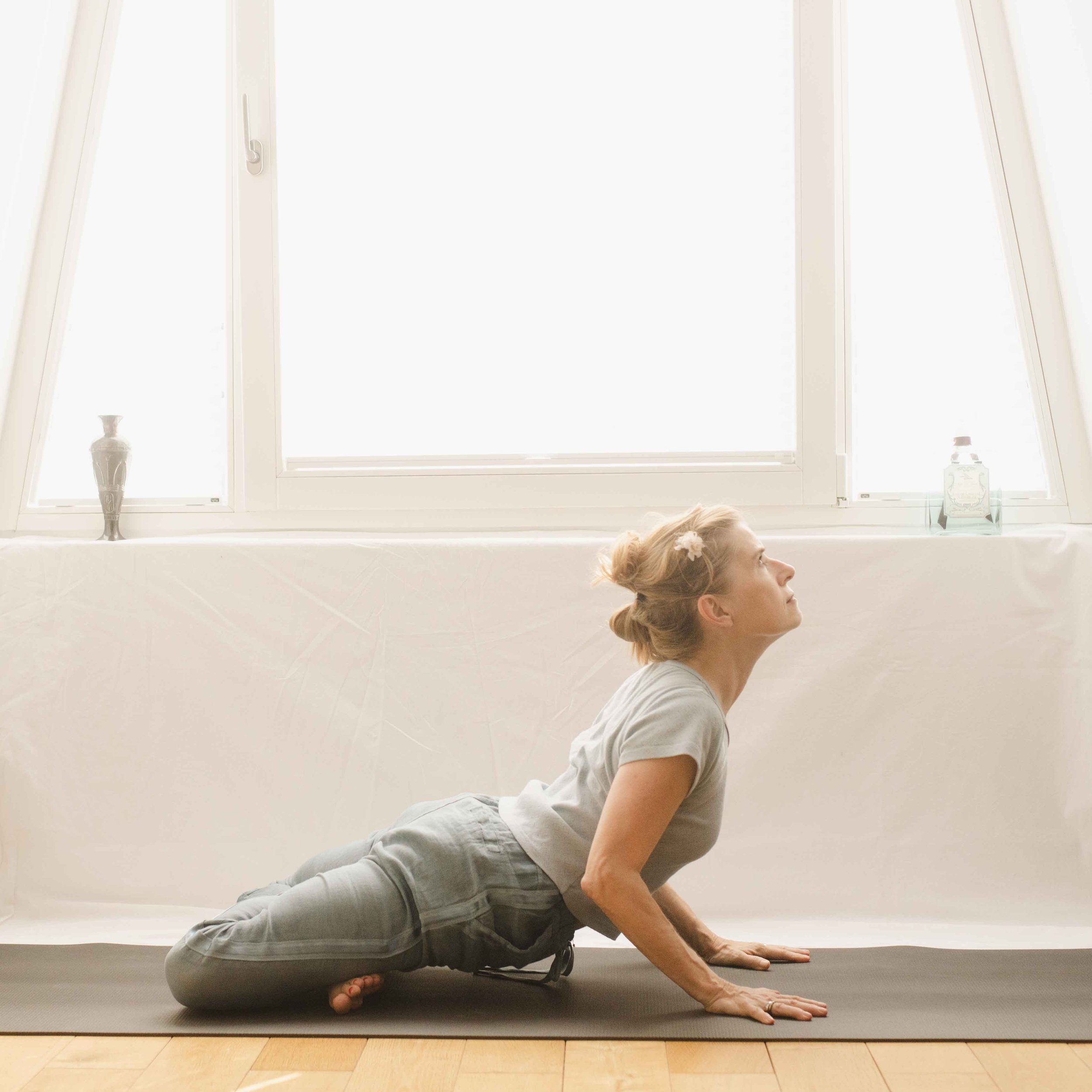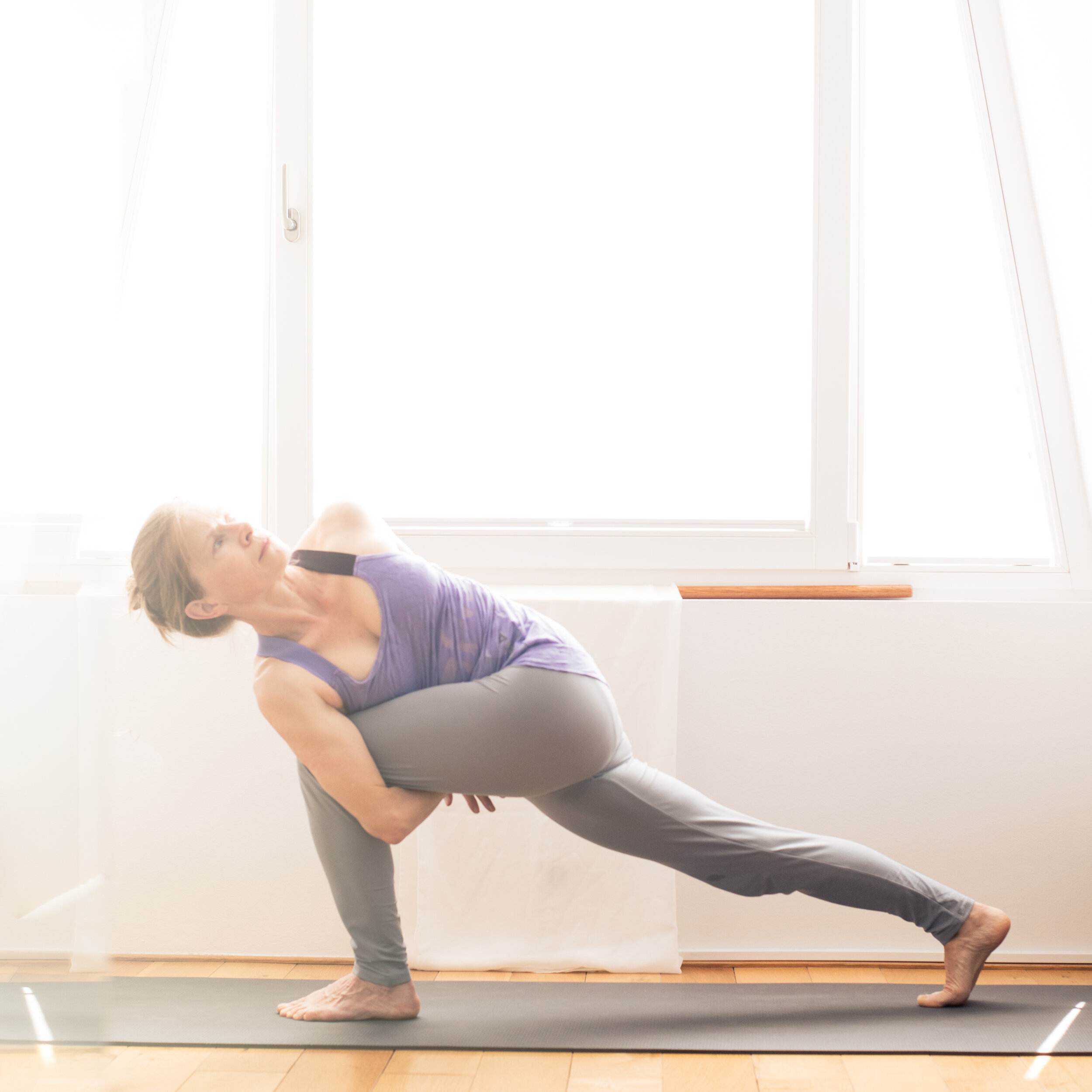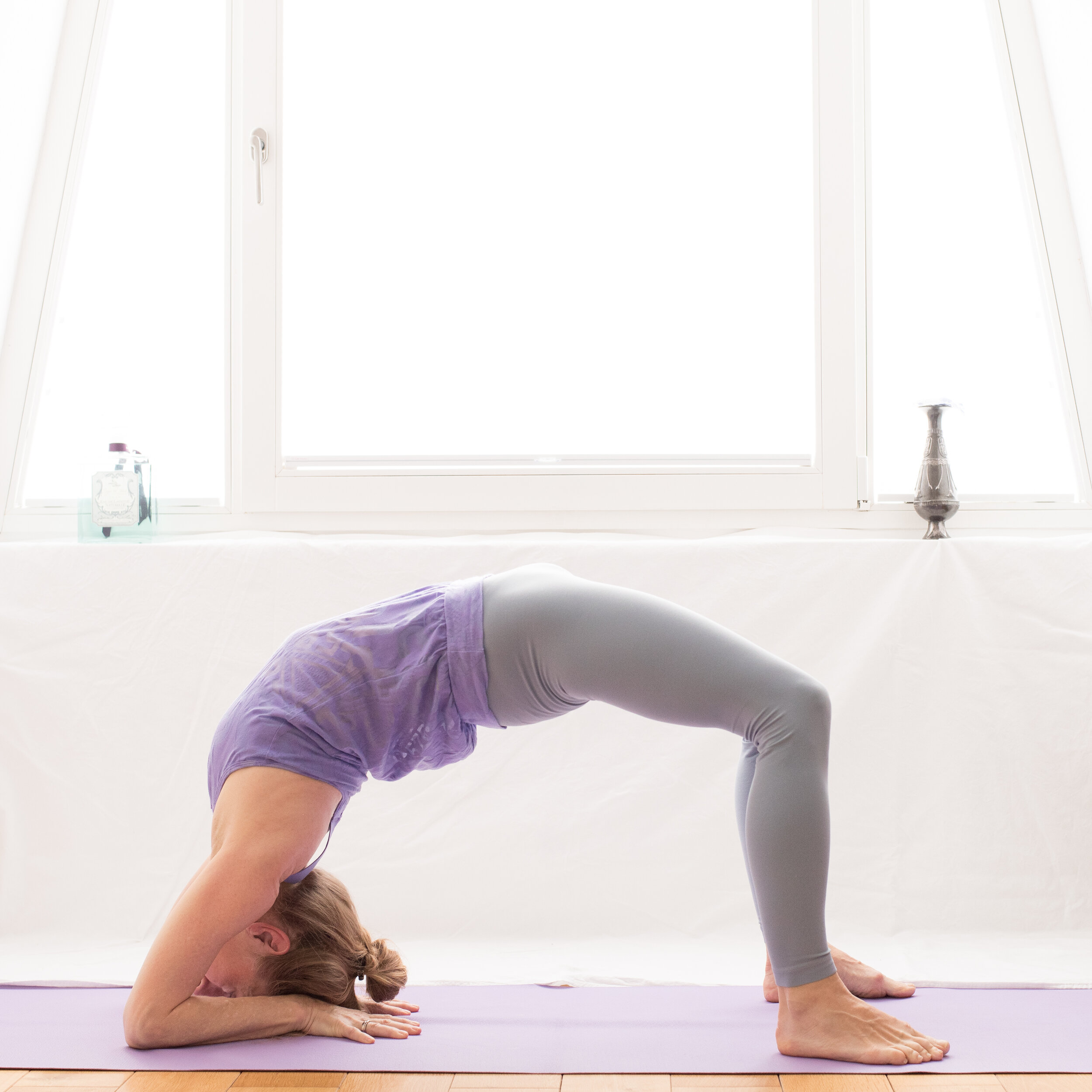You'll get out of your practices what you put in.
Consistency is a key word. That means success comes when you practice regularly whatever it is. It’s not only time that one can put into a practice. It can also be intensity, concentration, the right mindset, passion. intelligence. Work harder than smarter is true, too. In order to know what smarter is one has to study the practice. Experience and knowing oneself helps to understand and to judge methods and tips and tricks. It’s necessary to study the asana and the own strength and weaknesses in order to move forward in a steady way.
It’s recommended to study the art of yoga by oneself. The own practice is an excellent source. These days it’s also possible to find excellent teacher online. Books and podcasts are another source.
The pictures show two back bending asanas and one forward bending asana. It’s one of the rules that I follow: After an intensive back bending comes a soft forward bending asana or a twist. This balances the body again. It’s also relaxing and calms the nervous system.
Time that I put into my practice:
Ideally 9 hours of Ashtanga Yoga (first and second series) in the morning.
I watch YouTube Videos and tutorials on Omstars.
I scroll through my Instagram account from time to time. It motivates me to see all these diligent yogis. Sometimes it’s the kick that I need before a morning practice.
I write this blog again. It motivates me and documents my yoga journey.
When I started with Ashtanga Yoga my only source was the book by David Swenson ‘Ashtanga Yoga’.
My yoga week has started with an intensive practice. Keep practicing.
Ashtanga yoga - effective stretching
Back bending, August 2022
In Ashtanga yoga asanas are hold for five breaths. A vinyasa follows that connects one asana with the next one. Yet the holding time of an asana is only five breaths.
I learned that in the beginning of the Ashtanga movement asanas were held for eight breaths. Even this is rather short. But a practice becomes quickly very long if one holds every asana for a long time. I used to practice more than two hours when I was learning second series. This is too long for most people.
Practicing every day without any visible progress is frustrating. Within five breaths not so much can happen. It’s scarcely time to relax in a pose.
It’s possible to stretch more effectively. One must know how?
Staying in a position for one, two, three or even five minutes makes is more effective. To start modest helps to avoid injuries. Quickly it’s possible to prolong the holding time of an asana. Yet one also has to feel the stretching discomfort. Without any sensation, nothing will happen. Usually the discomfort fades away after a while. I know asanas that let me experience the opposite. The longer I hold it the more painful the position becomes. It varies from asana to asana. To breathe evenly and to relax helps to stand the stretching position. Only when the body is relaxed stretching will happen.
I usually pic a few asanas that are difficult for me. These days I work on back bending. Again! And forever!
Repetition is the second key. Each time stretching will get easier. The body allows to get deeper into a stretch.
I usually hold urdhva dhanurasana for 1 minute.
I’ll add two more asanas that I’ll hold 1 minute next week. It will be split pose and a pose that will stretch the upper body. This seems to be a realistic goal.
My timer is a precious tool. One minute can feel like five minutes. To have an external clue is useful. It is as if a trainer stands next to me.
The yoga week starts tomorrow.
Different levels of flexibility
Urdhva dhanurasana, July 2021
Being flexible can mean being able to do asana that require a stretched and flexible body.
Another level of flexibility is to switch easily from back bending to forward bending asanas and the other way round.
My back bending asanas feel good these days. Yet usually I practice easier back bending asanas first and then I move to more challenging ones. I start with salabhasana as recommended in the second Ashtanga yoga series. I exercise up to eight back bending asanas till I give my best at urdhva dhanurasana. The repetition of so many back bending asanas allows me to go deeper and deeper. At the end my body is soft and stretched. To bend backward feels good.
Today I practiced primary, because I need core strength. The movements between asanas are lost. It’s mainly jumping forward and jumping backwards. After all these vinyasa and forward bending asanas it was so difficult to practice urdhva dhanurasana. It felt so weakly and awkwarrdly that I consider to add preparation asanas next time.
The picture is taken yesterday without an intensive warm up. I think it’s visible. More is possible.
I’m sure that one can train the body to get fast from forward bending asanas to back bending asanas. It’s possible to switch fast from twists to balancing asanas. My body needs a bit more time to adjust.
These days I’m happy when I can get deeper into asanas. It’s OK to move from easy to challenging asanas. It’s fine to repeat asanas. There are ‘good’ days and ‘stiff’ days. The energy level changes every day. I learn to listen to my body.
Surely the more advanced a yogini is the less volatile is the practice. Nevertheless every day is different for everybody. This makes the yoga practice also interesting. Take care.
For me the playful practices are as precious as the ambitious practices.
Two more days and another yoga week is over.
Morning practices are the best
Bakasana, July 2021
The highlight this morning: Back bending felt good.
The mind is fresh and attentive in the morning. The body is strong and relaxed.
This morning the temperature was rather low. With every sun salutation I felt warmer and warmer. After 90 minutes I ended my practice, happy that I practice.
At the end of the day most of us feel exhausted. Me, too. The important rituals in my life have priorities therefore. They deserve being executed with energy.
It’s worth to find out if one is a morning person or a late riser. It can change when getting older.
Life needn’t aggravate when getting older. Following the life style off a yogi 🧘♂️ helps to stay fit and independent perhaps till the end.
Picture: Bakasana is a counter asana to back bending. Back bending and forward bending asanas and twists belong together.
Twists and back bending asanas
Twist, July 2020
The twists support back bending asanas. They can serve as a warm up for back bending. The twists open the upper body and move one shoulder after the other backwards. I got a feeling for the shoulder blades. They can actively support the process of twisting and bending backwards. The above asana is in addition a balancing challenge. Next challenge could be to lift the stretched leg. There is always another fancy variation. This keeps the practice lively and interesting. One must learn to be content with what is, even though there could be always more. The status quo is that something could be always better. It’s important to find highlights in the practice. To practice is alway the first accomplishment.
Today my yoga week began with second series, that is the focus was back bending. Two hours were over so quickly. I could stick to my plan. I held urdhva dhanurasana for over one minute. One minute can be rather long.
My timer allows to set intervals. This could be useful for poses that one wants to hold for five minutes for instance. To hear every minute a sound helps to be committed. One more minute is doable, five minutes sound so incredible long.
Difficulties to perform an asana are an opportunity to deepen the understanding of this asana. One learns to be patient, one learns to develop a plan, one learns to stay committed despite the stones on the path.
Time to cook. I’ll prepare eggplants with Basmati rice for us today. I’ve even a fresh water melon in the fridge. It could be our healthy dessert.
I wish my readers an awesome start in the new week.
Daily practice is the key
Slowly I understand asanas better and better. I know strength, stretching and balancing exercises. I know how to focus and breathe. My mind has learned to think: go for it, it’s possible. I also know that learning never stops. What we all know now, might be proved wrong tomorrow.
During my daily practice I always experience: Nothing is more important than the daily work, the daily practice if one wants to be a serious student of anything. The most effective exercise has no positive effect if not applied minimum three times a week, better every day.
That is after an intensive strength training, a break is recommended. Stretching must be done correctly as well.
My idea is to integrate supportive exercises in my morning practice. Sometimes I step on the mat in the evening as well, but not always. It’s summer time and it’s nice to go out for a walk in the evening.
It’s also important to find one’s own learning method. There are tested methods, but there is also an individual part. There is a tsunami of yoga tutorials on the internet. Many are produced so fast and they are so difficult to follow that they do more harm than good. I try to remember three exercises, when I watch a tutorial. During the next practice I try it. One cannot do everything. It’s too much. Everybody is a master today. Everybody has something to teach. To run from one exercise to the next makes no sense either. Firstly I’d like to being able to perform an exercise easily before moving on to the next challenge. Slowing down might finally speed up the learning process.
We learn from others a lot. It’s also possible to learn from the own practice.
The above exercise is a stretching exercise. Instead of virabhadrasana I practice the above pose as a preparation for the back bending.
My timer is always next to me. It’s easier to hold a pose longer when waiting for an external clue. The sound of a timer can get a lot of authority.
Become your own yoga teacher.
In the beginning of any journey one needs a map. To go to yoga classes is a very good idea. Not everything can be learned online. Feed-back is necessary. Adjustments are very important.
Right from the beginning on one can deepen one’s own practice alone at home. Home practices are possible from the very beginning on. It’s good to establish very early in one’s yoga journey a home practice. This brings independence. It shows what is learned, which asanas one can remember. To practice alone develops discipline till finally the practice becomes a habit.
After years, many yoga classes later, many workshops later, many tutorials on YouTube later, one becomes more experienced. This is the point when the yoga student does not only repeat what is learned. Own ideas change the practice. It’s possible to consider the own strength and weaknesses.
Questions might help to deepen the understanding of one’s own yoga journey:
Are there variations of an asana?
What is an easier version of a pose and what is a more difficult version?
Perhaps blogs might support the journey?
Are there different vinyasa?
What else can support the practice? Strength training? A different diet? Pranayama?
Can it make sense to explore other yoga styles than the preferred one?
What eating habits support the practice. What diet supports the practice and the body.
The asana on the picture is a preparation asana for pincha mayurasana. I prepare myself for falling. I’d like to land safely on my feet, no matter if I fall out of the pose forward or backward. I want to avoid injuries. This is why I adjust my practice. This is possible at home.
This asana also intensifies back bending in general. It stretches the upper body.
My yoga week at home started today. When I take another day off I’m sure these days that my body needs it. Saturday and Sunday I relaxed. Today I started with primary. The mind was so unfocused that I forgot several times if I had practiced the left side already. Sometimes the body is weak, sometimes the mind is wild.
Different levels of flexibility
There are different levels of flexibility.
I can do few asanas without a warm-up, without even preparing asanas. Lotus pose is such an asana, but also baddha konasana. I could mention other asanas, too.
There are asanas that I’m able to do, but only after a decent warm up and enough preparation. All the leg behind head poses are such asanas. I remember that I was able to do yoga nidra without any preparation. This has changed. These days I need a lot of preparation, but after the preparation all these leg behind head asanas are possible. They even feel good. To be more precise: When I practice primary the first leg behind head asana is supta kurmasana. I usually add all the leg behind head asanas from second series. I also add some extra exercises that turned out to be very useful and help me to relax in that advanced poses. This is all possible and I enjoy these asanas. It’s not possible to do one of these asanas without minimum half an hour ‘warming-up’.
Another level of flexibility is to switch from back bending to forward bending asanas. Usually these different forms are separated by twists. Twists shall neutralize the body. I think my back bending asanas are very OK, my forward bending asanas are very OK, too, but to switch from back bending to forward bending asanas is almost impossible. All the leg behind head asanas are not possible when I practice second series. I do preparing exercises only. I lost this level of flexibility.
The most intensive asanas feel better and better. This is for me the best sign that I’m on the right track.
I practice daily and this makes the difference. The body and also the mind like routines. I feel that I make progress again.
Learn to learn
On the surface we learn asanas. True is we learn much more than just asanas. Many things that we learn are not visible at first sight.
We learn that when we have the thought or the feeling we’re done, we’re still able to hold a pose a bit longer or to do another chaturanga dandasana. Beginner give up much earlier than more experienced yogini.
We learn to bear discomfort. In order to bear discomfort it’s useful to keep breathing evenly. This helps to relax despite the discomfort or pain.
With time we get to know our limits. We often can do much more than we think. This is the experience that we can make over time. With this knowledge we’re often able to do a bit more than usual.
This post got inspired by the Saturday night competition show ‘Let’s dance’. Twelve celebrity try to win. Every Friday a couple ( a celebrity who dances with a professional dancer) is out. The couples get judged by a jury and the spectators who can vote by phone for her favorite dancer.
The dancer have different qualifications. Some are sportive already, they climb and run. Others are musicians. Some have experience to be on stage. Others are not so experienced. Those who are not so experienced perform better when they dance in a group. They profit much more from the energy of others than those who are more experienced.
I think that the more experienced we are the more we’re able to exercise alone without the energy of a group. Everybody can profit from a group and group training, yet for those who are not used to exercise it can make a huge difference.
The Ashtanga Yoga week has started. At 6:30 am I began with the first sun salutations. The practice today was very intensive. Focus was back bending. Slowly it becomes again a joy to bend backwards.
Too experienced to risk an injury
There is another yoga challenge by @cyogalife on Instagram. The April challenge is called #BackOnTrack. Carmen is a very advanced yogini. She practices yoga every day for 2 hours minimum. She is a teacher. Yoga is her life. It’s a very good idea to offer a challenge that speaks also to the advanced yoginis. I like challenges that deserve the name. She gives useful explanations. There are also alternate asanas that are easier to approach.
Nevertheless I know my body and its possibilities. Maybe that sometimes more is possible than I think, but often my insights meet reality. I prefer a slow approach to the asanas I want to learn. The asana yesterday was a back bending asana. Here we go. When I tried to bend the stretched leg, my muscles cramped. This is not a nice feeling. I found a back bending asana that was possible for me. Even the easier asana was not possible for me. These challenges are made to explore new positions, new approaches. It’s not about performing everything as it’s proposed. Every practice is about finding the limits of a given day. One can push oneself, but never too much.
Injuries are setbacks.
It’s getting warmer here in Germany. I get up early as I don’t want to miss the sun rise. Best time for a yoga practice is the early morning. I got used again to practice before breakfast. I don’t feel hungry at all. When I start with the sun salutations, I focus on my breath. Every day is a good day when I practiced.
Injuries happen easier after a break. A daily practice helps to avoid injuries. This is just a reminder.
Being overambitious can be a danger, too. Yoginis don’t lose their cool. 😎 Nothing must be proved. The journey itself is the fun.
After my so deserved breakfast I lied on my bed again and slept. At once.
